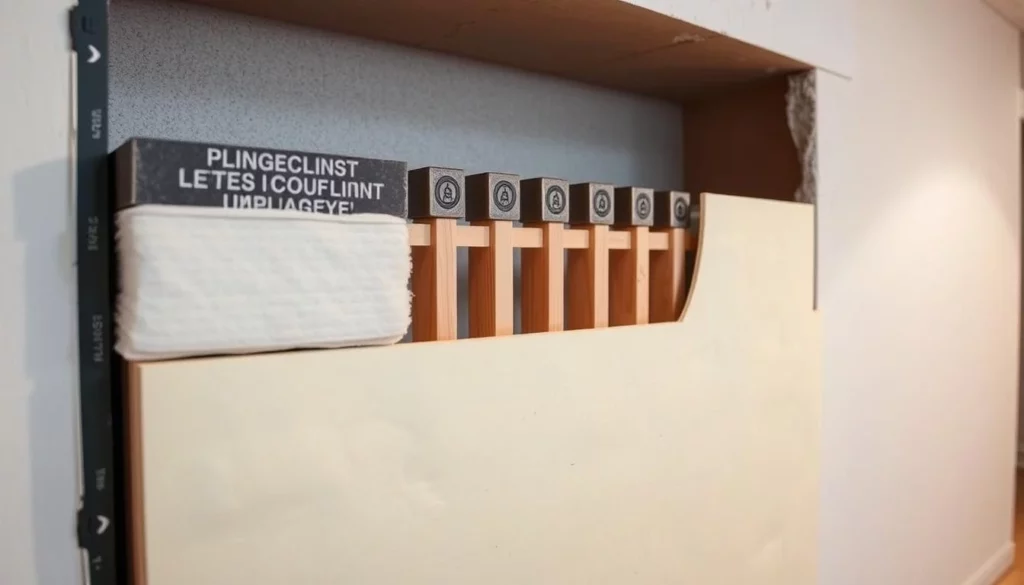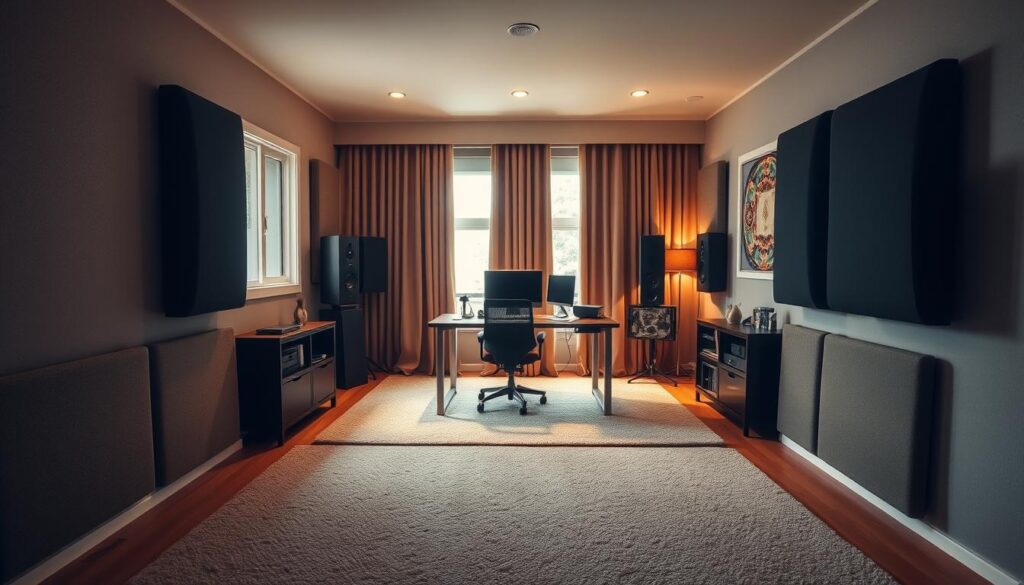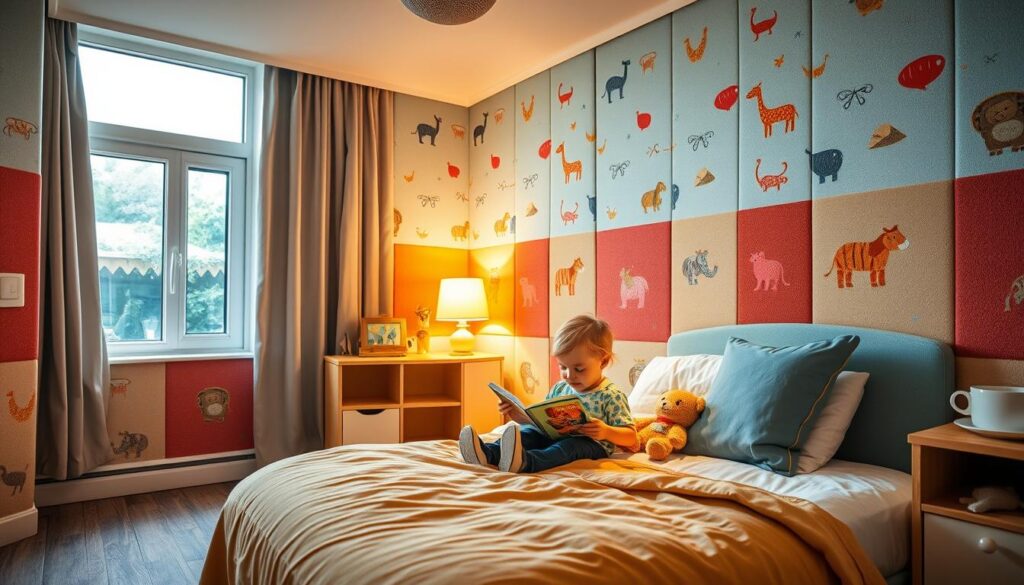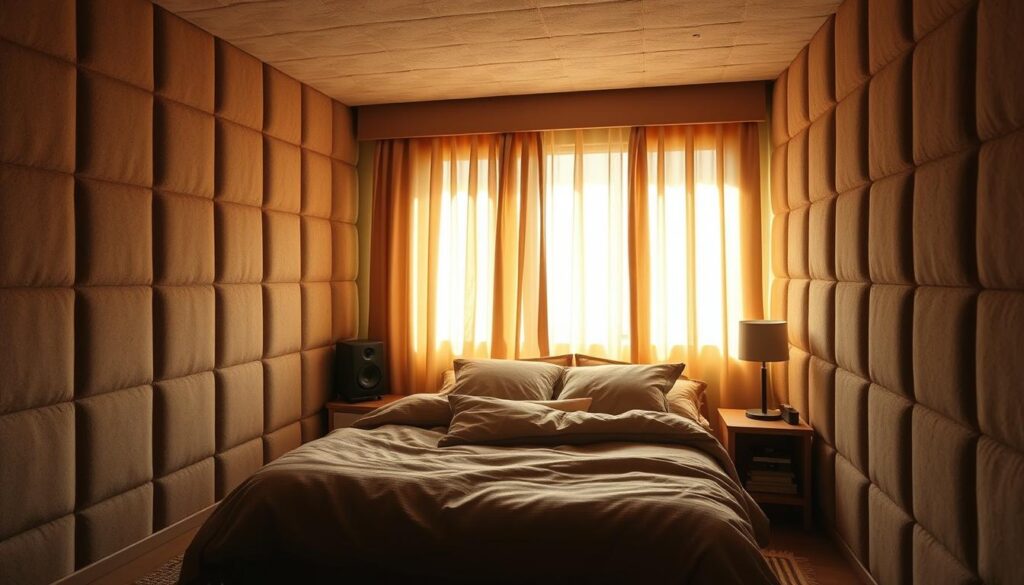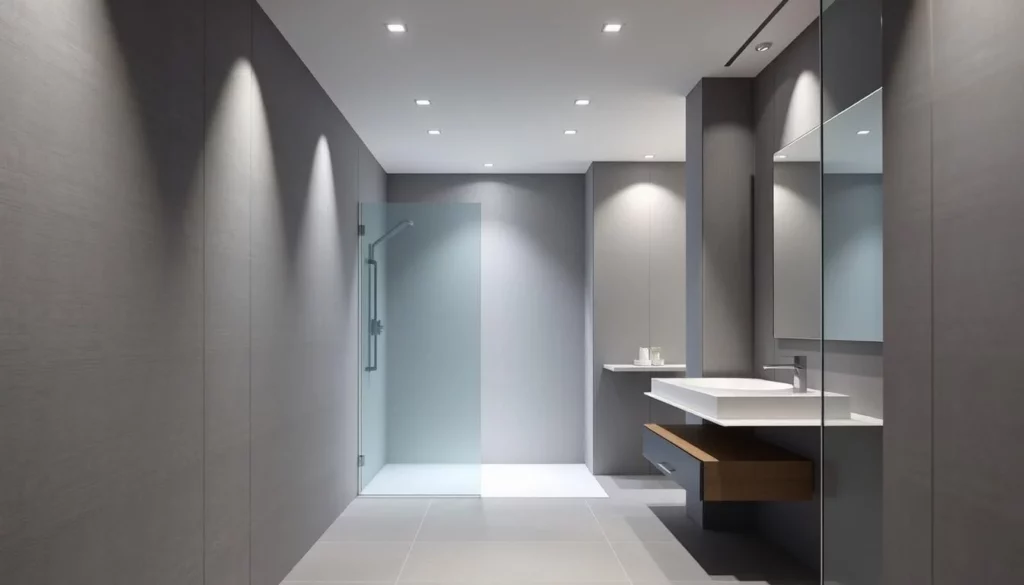If you live in a duplex or townhome, you know the problem of hearing your neighbors. Noise pollution can really mess up your life and peace. It’s a big issue in shared housing.
Soundproofing can really help. It can make your home quieter and more peaceful. This article will show you how to do it. We’ll focus on townhome wall soundproofing and duplex soundproofing tips.
Learn more about soundproofing.
Understanding the Importance of Soundproofing
Noise pollution is a big problem in shared housing. Soundproofing can help solve this issue. Living in a duplex or townhome means you often hear sounds from next door. This can be a big problem, whether you’re working from home, trying to relax, or have different schedules than your neighbors.
Using soundproofing solutions can make your living space better by reducing noise. It’s not just about being nice to your neighbors. It’s also about making your home a peaceful place for yourself. Learning about soundproofing is the first step to a quieter home.
Why Soundproofing Matters for Duplexes and Townhomes
Duplexes and townhomes have shared walls, which can let noise through. Impact noise, like footsteps, and airborne noise, like loud music, can easily pass through these walls. Soundproofing helps block these noises, so you can enjoy your home without interruptions.
Also, soundproofing can make your property more valuable. A quiet, well-insulated home is more appealing to buyers and can sell for more. So, investing in soundproofing is smart for both now and the future.
Common Noise Issues Faced by Residents
Residents of duplexes and townhomes often deal with noise problems. Loud music, talking, and footsteps from next door are common. These noises can be really annoying, whether it’s during the day or at night when you’re trying to rest or focus.
To fix these problems, you need to know what kind of noise you’re dealing with. Is it always there, or does it happen at certain times? Knowing this helps you find the best noise reduction techniques to use.
By recognizing the need for soundproofing and understanding common noise issues, you can make your living space better. This improves your life and helps you get along better with your neighbors.
Types of Noise to Address
The first step in soundproofing is recognizing the various types of noise that need to be addressed. When living in duplexes or townhomes, you’re likely to encounter different kinds of noise coming through shared walls.
Impact Noise vs. Airborne Noise
There are two primary types of noise: impact noise and airborne noise. Impact noise is generated by direct contact or vibration, such as footsteps or objects hitting the floor or walls. On the other hand, airborne noise refers to sounds that travel through the air, like conversations, TV sounds, or music.
Understanding the difference between these two types is crucial for selecting the right soundproofing materials and techniques. For instance, impact noise might require more substantial solutions like adding insulation or using specialized flooring.
Examples of Common Noises in Shared Walls
Common noises you might encounter include:
- Footsteps and walking
- Loud conversations and TV sounds
- Music and other entertainment noises
- Door slamming and other sudden impacts
Identifying these noises is the first step towards finding an effective solution. By understanding the types of noise you’re dealing with, you can choose the most appropriate soundproofing materials and consult with soundproofing contractors if needed.
Choosing the Right Soundproofing Material
When you’re soundproofing shared walls in duplexes and townhomes, picking the right materials is key. The material you choose depends on the noise you want to block and your home’s construction.
Acoustic Panels: Pros and Cons
Acoustic panels are a favorite for soundproofing. They soak up sound waves, cutting down on echo and reverberation. They’re good for sound quality and look nice, but they’re not perfect. They don’t work well against low sounds and can be pricey.
Here are some benefits of acoustic panels:
- They cut down echo and reverberation well
- They look good, with many designs and colors
- You can hang them on walls or ceilings
For more soundproofing tips, check out Soundproof Cow. They offer soundproofing materials and expert advice.
Adding Insulation: Types and Benefits
Insulation is also great for soundproofing. It fills gaps and cavities in walls, stopping sound waves. You can choose from fiberglass, cellulose, and spray foam.
Insulation has many benefits:
- It saves energy by reducing heat transfer
- It’s good at blocking noise
- It can be added to existing walls with little disruption
By picking the right soundproofing material, you can make your home quieter.
DIY Soundproofing Solutions
Living in a duplex or townhome can make soundproofing shared walls tough. But, with the right DIY solutions, you can cut down noise a lot.
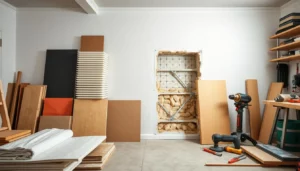
Simple Techniques to Reduce Noise
One easy way to soundproof is by adding caulk to seams and gaps. This seals air gaps that let noise pass through. Another trick is to put flooring underlayment down. It helps block impact noise, like footsteps.
Using acoustic panels on walls and ceilings can also work well. They soak up airborne noise. Plus, area rugs and heavy curtains can help dampen sound. These methods are budget-friendly and simple to do.
When to Consider Professional Help
While DIY solutions are great, sometimes you need professional help. If DIY methods don’t work, it’s time to call a soundproofing expert.
Experts can give you custom solutions that might be more effective and cost-effective. They can handle complex issues, like soundproofing rooms or dealing with structural noise.
For those in duplexes and townhomes, knowing when to DIY and when to get help is crucial. Mixing DIY tricks with expert advice can make your living space quieter and more peaceful.
Assessing Your Current Soundproofing Situation
The first step in soundproofing your home is to check your current setup. You need to know what’s working and what’s not. This helps you find where you need to make changes.
Identifying Problem Areas
Start by noticing the types of noise you hear and where they come from. Are they sounds that travel through the air, like voices or music? Or are they sounds from impacts, like footsteps? Make a list of where the noise is loudest.
Try a simple test by playing music or making noise on one side of a shared wall. Then, listen for it on the other side. This will show you where your soundproofing needs work.
Evaluating Existing Solutions
If you’ve tried soundproofing before, check how well it’s working. See if the materials you used are right for the noise you’re trying to block. For example, acoustic panels work well against airborne noise but not as much against impact noise.
| Soundproofing Material | Effectiveness Against Airborne Noise | Effectiveness Against Impact Noise |
|---|---|---|
| Acoustic Panels | High | Low |
| Insulation | Medium | Medium |
| Soundproofing Blankets | Medium | Low |
By checking your current soundproofing and how well it works, you can choose the best way to make your home quieter.
Utilizing Soft Furnishings for Noise Reduction
Using soft furnishings to absorb and reduce noise is often overlooked. They can significantly help in making living spaces quieter. By choosing the right items, you can make your home more peaceful.
The Role of Rugs and Curtains
Rugs and curtains do more than just look good. They can also help block sound. Thick rugs can soak up the sound of footsteps, keeping it from spreading. Heavy curtains or drapes can also cut down on airborne noise.
When picking rugs and curtains for soundproofing, go for dense and heavy materials. Choose rugs with thick underlays or made from sound-absorbing materials. For curtains, pick thick, lined drapes to block sound better.
Strategic Placement of Furniture
Where you place your furniture can also help with noise reduction. Placing furniture against shared walls can act as a sound barrier. For instance, a bookshelf or a big piece of furniture can block noise.
Arranging furniture to create separate areas can also help keep noise in check. This way, you can reduce overall noise levels. For expert advice on soundproofing your space, consider talking to soundproofing contractors.
Acoustic Sealing Techniques
Soundproofing shared walls often misses a key point: acoustic sealing. It’s essential for blocking noise through wall gaps and cracks.
Understanding Air Gaps and Their Importance
Air gaps are small openings that can ruin soundproofing. They’re found around windows, doors, and where different materials meet. Sealing these gaps is key for good soundproofing.
Understanding Air Gaps
Air gaps let sound travel between spaces, making soundproofing less effective. Sealing them boosts your home’s soundproofing. Common spots include wall and ceiling joints, plumbing, and behind outlets.
Effective Materials for Sealing Cracks
Many materials can seal cracks well. Here are a few:
- Caulk: Flexible and great for windows, doors, and joints.
- Spray foam: Fills big gaps and seals tight.
- Acoustic sealant: Made for soundproofing, stays flexible and works well over time.
Using these materials right can maximize your soundproofing. For soundproofing cost estimation, think about the work and materials needed. Sealing well is a smart soundproofing tip that greatly reduces noise.
Professional Soundproofing Services
If you’re having trouble with noise in your duplex or townhome, it might be time to get help from a professional. DIY methods can help some, but complex issues need expert help.
When to Hire a Professional
Think about hiring a professional if DIY methods don’t work. This is true if you face:
- Constant noise that messes with your daily life or sleep.
- Complex soundproofing needs, like shared walls with many noise sources.
- Structural problems that need fixing along with soundproofing.
Professional soundproofing services offer custom solutions. They not only cut down on noise but also make your living space better.
What to Expect from a Soundproofing Consultation
A professional will check your noise problems and suggest fixes during a consultation. Here’s what you’ll get:
| Service | Description |
|---|---|
| Noise Assessment | They’ll find out what kinds of noise you’re dealing with and where it’s coming from. |
| Customized Solutions | They’ll give you plans that fit your soundproofing needs exactly. |
| Implementation Plan | They’ll show you how to soundproof, including what materials you’ll need. |
By choosing a professional, you make sure the soundproofing works well and lasts a long time. This means less noise for you in the long run.
Investing in duplex soundproofing or townhome wall soundproofing can really improve your life. It makes your home quieter and more peaceful. Professional services are a reliable way to get there.
Legal Considerations and Rental Agreements
Soundproofing shared walls is more than just cutting down on noise. It’s also about knowing your rights and duties. Living in a duplex or townhome means you need to understand the legal side of soundproofing. This knowledge helps you deal with neighbors and follow your rental agreement.
Understanding Noise Regulations in Shared Housing
Noise laws differ by place, but most have rules against loud noises that disrupt peace. As a resident in shared housing, knowing these laws is crucial. It helps you avoid fines and neighbor disputes. Check your local noise laws and know what’s considered a disturbance.
Some important things to look at include:
- Quiet hours: Many places have quiet times, usually at night.
- Noise levels: Some areas have decibel limits, and going over can lead to penalties.
- Types of noise: Laws often list specific noises that are disturbances, like loud music or barking.
Communicating with Neighbors About Sound Issues
Talking to your neighbors about noise is key to solving problems peacefully. If you’re bothered by noise, talk to your neighbors about it. Often, people don’t realize how loud they are, and a friendly chat can fix the problem.
When you talk to your neighbors about noise:
- Be kind and polite.
- Tell them the problem and how it affects you.
- Offer solutions that work for both of you.
Knowing the noise laws and talking openly with neighbors can greatly reduce noise problems. This approach not only solves current issues but also makes living together better.
Adding soundproofing solutions can make your home quieter. Whether you own or rent, looking into noise reduction techniques is a smart move. It improves your home’s comfort and value.
Cost of Soundproofing Shared Walls
Understanding the costs of soundproofing shared walls is key. The price can change a lot, depending on if you choose DIY or hire pros.
Budget-Friendly Options vs. High-End Solutions
If you’re watching your wallet, there are affordable soundproofing options. DIY soundproofing solutions are cheap. You can use acoustic panels, add more insulation, and seal gaps around doors and windows.
- Acoustic panels cost between $20 to $100 each, based on size and quality.
- Insulating walls can cost $1 to $3 per square foot.
- Sealants and caulk for gaps are just $5 to $10 per tube.
But, if you want top-notch soundproofing, hiring pros is pricier. Yet, they offer better and longer-lasting results.
Average Costs to Expect for Various Methods
The cost of soundproofing shared walls can differ a lot, based on the method. Here are some average prices:
| Soundproofing Method | Average Cost |
|---|---|
| DIY Acoustic Panels | $50 – $500 |
| Professional Soundproofing Services | $500 – $5,000 |
| Adding Insulation | $300 – $1,500 |
It’s important to think about your specific needs and budget before picking a soundproofing method. Talking to soundproofing contractors can help find the best and most affordable solution for you.
Maintaining Soundproofing Over Time
Keeping your soundproofing effective requires regular care. Over time, wear and tear can weaken your soundproofing. This lets noise back in.
Regular Checks
Make it a habit to check your soundproofing often. This includes acoustic panels, insulation, and seals. Look for damage or wear and fix it right away.
Upkeep and Repair
Keeping your soundproofing in good shape helps block noise. Think about the cost when you need repairs or replacements. Small fixes, like sealing gaps or tightening loose parts, can help a lot.
By focusing on upkeep, you can keep your space quiet and peaceful. Soundproofing is a continuous effort. But, the quiet it brings is worth it.
